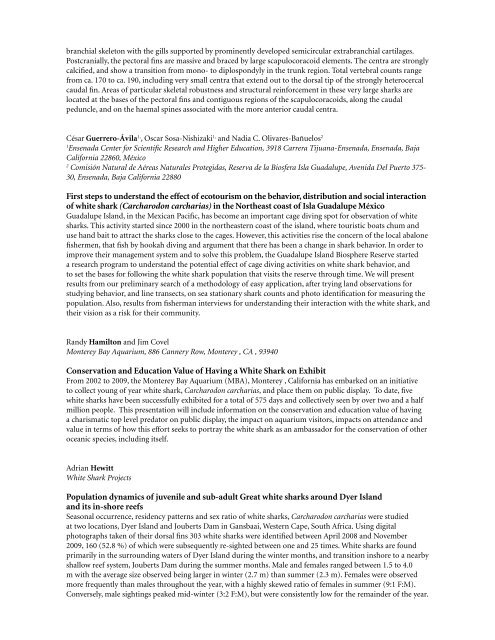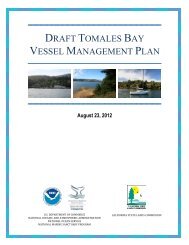Symposium program - Gulf of the Farallones National Marine ...
Symposium program - Gulf of the Farallones National Marine ...
Symposium program - Gulf of the Farallones National Marine ...
Create successful ePaper yourself
Turn your PDF publications into a flip-book with our unique Google optimized e-Paper software.
anchial skeleton with <strong>the</strong> gills supported by prominently developed semicircular extrabranchial cartilages.<br />
Postcranially, <strong>the</strong> pectoral fins are massive and braced by large scapulocoracoid elements. The centra are strongly<br />
calcified, and show a transition from mono- to diplospondyly in <strong>the</strong> trunk region. Total vertebral counts range<br />
from ca. 170 to ca. 190, including very small centra that extend out to <strong>the</strong> dorsal tip <strong>of</strong> <strong>the</strong> strongly heterocercal<br />
caudal fin. Areas <strong>of</strong> particular skeletal robustness and structural reinforcement in <strong>the</strong>se very large sharks are<br />
located at <strong>the</strong> bases <strong>of</strong> <strong>the</strong> pectoral fins and contiguous regions <strong>of</strong> <strong>the</strong> scapulocoracoids, along <strong>the</strong> caudal<br />
peduncle, and on <strong>the</strong> haemal spines associated with <strong>the</strong> more anterior caudal centra.<br />
César Guerrero-Ávila 1, , Oscar Sosa-Nishizaki 1, and Nadia C. Olivares-Bañuelos 2<br />
1<br />
Ensenada Center for Scientific Research and Higher Education, 3918 Carrera Tijuana-Ensenada, Ensenada, Baja<br />
California 22860, México<br />
2<br />
Comisión Natural de Aéreas Naturales Protegidas, Reserva de la Biosfera Isla Guadalupe, Avenida Del Puerto 375-<br />
30, Ensenada, Baja California 22880<br />
First steps to understand <strong>the</strong> effect <strong>of</strong> ecotourism on <strong>the</strong> behavior, distribution and social interaction<br />
<strong>of</strong> white shark (Carcharodon carcharias) in <strong>the</strong> Nor<strong>the</strong>ast coast <strong>of</strong> Isla Guadalupe México<br />
Guadalupe Island, in <strong>the</strong> Mexican Pacific, has become an important cage diving spot for observation <strong>of</strong> white<br />
sharks. This activity started since 2000 in <strong>the</strong> nor<strong>the</strong>astern coast <strong>of</strong> <strong>the</strong> island, where touristic boats chum and<br />
use hand bait to attract <strong>the</strong> sharks close to <strong>the</strong> cages. However, this activities rise <strong>the</strong> concern <strong>of</strong> <strong>the</strong> local abalone<br />
fishermen, that fish by hookah diving and argument that <strong>the</strong>re has been a change in shark behavior. In order to<br />
improve <strong>the</strong>ir management system and to solve this problem, <strong>the</strong> Guadalupe Island Biosphere Reserve started<br />
a research <strong>program</strong> to understand <strong>the</strong> potential effect <strong>of</strong> cage diving activities on white shark behavior, and<br />
to set <strong>the</strong> bases for following <strong>the</strong> white shark population that visits <strong>the</strong> reserve through time. We will present<br />
results from our preliminary search <strong>of</strong> a methodology <strong>of</strong> easy application, after trying land observations for<br />
studying behavior, and line transects, on sea stationary shark counts and photo identification for measuring <strong>the</strong><br />
population. Also, results from fisherman interviews for understanding <strong>the</strong>ir interaction with <strong>the</strong> white shark, and<br />
<strong>the</strong>ir vision as a risk for <strong>the</strong>ir community.<br />
Randy Hamilton and Jim Covel<br />
Monterey Bay Aquarium, 886 Cannery Row, Monterey , CA , 93940<br />
Conservation and Education Value <strong>of</strong> Having a White Shark on Exhibit<br />
From 2002 to 2009, <strong>the</strong> Monterey Bay Aquarium (MBA), Monterey , California has embarked on an initiative<br />
to collect young <strong>of</strong> year white shark, Carcharodon carcharias, and place <strong>the</strong>m on public display. To date, five<br />
white sharks have been successfully exhibited for a total <strong>of</strong> 575 days and collectively seen by over two and a half<br />
million people. This presentation will include information on <strong>the</strong> conservation and education value <strong>of</strong> having<br />
a charismatic top level predator on public display, <strong>the</strong> impact on aquarium visitors, impacts on attendance and<br />
value in terms <strong>of</strong> how this effort seeks to portray <strong>the</strong> white shark as an ambassador for <strong>the</strong> conservation <strong>of</strong> o<strong>the</strong>r<br />
oceanic species, including itself.<br />
Adrian Hewitt<br />
White Shark Projects<br />
Population dynamics <strong>of</strong> juvenile and sub-adult Great white sharks around Dyer Island<br />
and its in-shore reefs<br />
Seasonal occurrence, residency patterns and sex ratio <strong>of</strong> white sharks, Carcharodon carcharias were studied<br />
at two locations, Dyer Island and Jouberts Dam in Gansbaai, Western Cape, South Africa. Using digital<br />
photographs taken <strong>of</strong> <strong>the</strong>ir dorsal fins 303 white sharks were identified between April 2008 and November<br />
2009, 160 (52.8 %) <strong>of</strong> which were subsequently re-sighted between one and 25 times. White sharks are found<br />
primarily in <strong>the</strong> surrounding waters <strong>of</strong> Dyer Island during <strong>the</strong> winter months, and transition inshore to a nearby<br />
shallow reef system, Jouberts Dam during <strong>the</strong> summer months. Male and females ranged between 1.5 to 4.0<br />
m with <strong>the</strong> average size observed being larger in winter (2.7 m) than summer (2.3 m). Females were observed<br />
more frequently than males throughout <strong>the</strong> year, with a highly skewed ratio <strong>of</strong> females in summer (9:1 F:M).<br />
Conversely, male sightings peaked mid-winter (3:2 F:M), but were consistently low for <strong>the</strong> remainder <strong>of</strong> <strong>the</strong> year.







